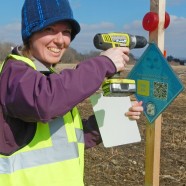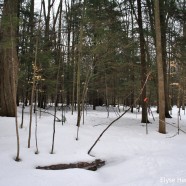Sign Removal
Spring has seemingly sprung, and that means we are wrapping up our winter projects and beginning to plan for the upcoming summer field season. With the conclusion of winter, our “Nature at Your Fingertips” winter trails cell phone tour signs are coming down off the trail and will be stored away until fall. We’ll be posting more updates soon on how this year’s tour went and what cell phones tours will be going up elsewhere in our area.
Read MoreGoodbye March Sky
As we say goodbye to March and its cold, dark and dreary skies we turn a hopeful eye to April when perhaps – after more chilly weather and possibly snow – we will see a return to normal climate conditions and much more life outdoors. March came in like a lion and and is leaving like a lion, but the sun will win. It always does. Warmth and growth are coming. Perhaps a lamb, too! Scott Kruitbosch Conservation & Outreach Coordinator
Read MoreWe Didn’t Find Anything…And That’s a Good Thing!
After two months of intensive winter survey work, we found nothing. However, that’s precisely the result we wanted. As you’ve probably seen or heard, this past winter we surveyed several sites throughout the area looking exclusively for Hemlock Woolly Adelgid (HWA), an invasive insect that puts all Eastern Hemlock trees (Tsuga canadensis), the habitats they make up and the wildlife they support at risk. This particular pest is minute, but can bring a tree to its death within a matter of 3-5 years if left unchecked and untreated. In response to this, several organizations, state...
Read MoreVernal Pools Poking Through
Last weekend as we were out surveying for HWA in Dobbin’s Woods, a beautiful Chautauqua Watershed Conservancy property, we came across several little pools beginning to form in the depressions of the landscape as the snow increasingly melts back. While these pools aren’t too attractive for us to throw our beach chair next to, they are extremely important to a number of amphibian species. In the upcoming weeks these small pools will serve as little nurseries for salamander and frog offspring to safely develop from egg-y masses to free swimming larvae to land conquering tetrapods....
Read MoreEastern Phoebe Wet & Cold
This Eastern Phoebe is wet and cold today, and I had to crank up the ISO to get a recognizable photo of it in these dreary and foggy conditions. You can also see the snow on the ground behind the bird as we continue to have cover throughout the region. Even though it feels like a “warm” day we are still below our normal temperatures. Despite that the southerly flow has brought in migrants like this one. Have you had your Phoebe yet? Scott Kruitbosch Conservation & Outreach Coordinator
Read More








